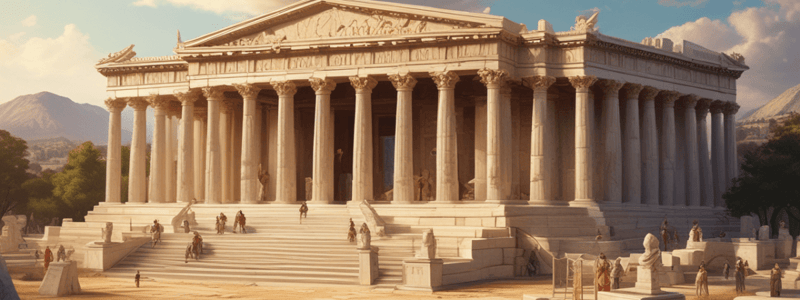Podcast
Questions and Answers
Athenian democracy included a unique practice called ______, whereby citizens could vote to banish a prominent individual from the city-state for a period of ten years.
Athenian democracy included a unique practice called ______, whereby citizens could vote to banish a prominent individual from the city-state for a period of ten years.
ostracism
Ostracism was intended to prevent the rise of tyrants or individuals deemed a threat to the ______ order.
Ostracism was intended to prevent the rise of tyrants or individuals deemed a threat to the ______ order.
democratic
Participation in Athenian democracy was restricted to a relatively small portion of the ______.
Participation in Athenian democracy was restricted to a relatively small portion of the ______.
population
Athenian democracy excluded ______, slaves, and foreigners from decision-making.
Athenian democracy excluded ______, slaves, and foreigners from decision-making.
Athenian democracy has influenced subsequent democratic systems around the ______.
Athenian democracy has influenced subsequent democratic systems around the ______.
Athenian democracy was established in ancient Athens, Greece, around the 5th century ______.
Athenian democracy was established in ancient Athens, Greece, around the 5th century ______.
Key features of Athenian democracy include Direct ______.
Key features of Athenian democracy include Direct ______.
Only adult male citizens of Athens were considered eligible to participate in the ______ process.
Only adult male citizens of Athens were considered eligible to participate in the ______ process.
The Assembly was the primary democratic institution in Athens.It met regularly on a hill called the ______.
The Assembly was the primary democratic institution in Athens.It met regularly on a hill called the ______.
Athenian democracy also included a system of courts and ______ where citizens served as judges.
Athenian democracy also included a system of courts and ______ where citizens served as judges.
Jurors were chosen by lot from a pool of eligible citizens and were responsible for hearing cases and rendering ______.
Jurors were chosen by lot from a pool of eligible citizens and were responsible for hearing cases and rendering ______.
What was the primary democratic institution in ancient Athens?
What was the primary democratic institution in ancient Athens?
Which of the following groups were excluded from participating in Athenian democracy?
Which of the following groups were excluded from participating in Athenian democracy?
What was the purpose of the Athenian practice of $ extit{ostracism}$?
What was the purpose of the Athenian practice of $ extit{ostracism}$?
What was the primary form of decision-making in Athenian democracy?
What was the primary form of decision-making in Athenian democracy?
Where did the Athenian Assembly (Ekklesia) regularly meet?
Where did the Athenian Assembly (Ekklesia) regularly meet?
What was the role of citizens in the Athenian judicial system?
What was the role of citizens in the Athenian judicial system?
Which of the following statements about ostracism is true?
Which of the following statements about ostracism is true?
What was the primary limitation of Athenian democracy?
What was the primary limitation of Athenian democracy?
What was the primary purpose of ostracism in Athenian democracy?
What was the primary purpose of ostracism in Athenian democracy?
Which of the following statements about Athenian democracy is true?
Which of the following statements about Athenian democracy is true?
How has Athenian democracy influenced subsequent democratic systems?
How has Athenian democracy influenced subsequent democratic systems?
Flashcards are hidden until you start studying
Study Notes
Athenian Democracy
- Athenian democracy was a political system established in ancient Athens, Greece, around the 5th century BCE.
- It is regarded as one of the earliest forms of democracy in the world.
Key Features
- Direct Democracy: Citizens directly participated in decision-making, gathering in the Assembly (Ekklesia) to debate and vote on laws, policies, and important matters of state.
- Citizenship: Only adult male citizens of Athens were eligible to participate in the democratic process, excluding women, slaves, and foreigners.
Assembly (Ekklesia)
- The Assembly was the primary democratic institution in Athens.
- It met regularly on a hill called the Pnyx, around 40 times a year.
- Any citizen could attend, speak, and vote on issues brought before the Assembly.
Juries and Courts
- Athenian democracy included a system of courts and juries where citizens served as judges.
- Jurors were chosen by lot from a pool of eligible citizens and were responsible for hearing cases and rendering verdicts.
Ostracism
- Ostracism was a unique practice in Athenian democracy, where citizens could vote to banish a prominent individual from the city-state for a period of ten years.
- This was intended to prevent the rise of tyrants or individuals deemed a threat to the democratic order.
Limitations of Democracy
- Participation in Athenian democracy was restricted to a relatively small portion of the population, excluding women, slaves, and foreigners.
- Despite its limitations, Athenian democracy remains an important historical example of democratic governance and has influenced subsequent democratic systems around the world.
Studying That Suits You
Use AI to generate personalized quizzes and flashcards to suit your learning preferences.


